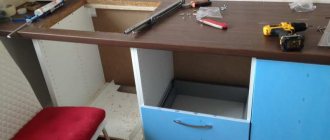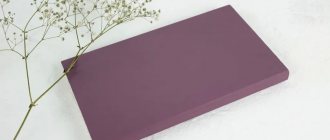- Home"
- DIY furniture restoration
Do-it-yourself furniture restoration is a difficult but interesting job that allows you to restore your favorite interior items. By spending a little time, you can make a comfortable, stylish wardrobe out of an old wardrobe, or make an addition to a designer table out of your grandmother’s chair. In order for the result to meet your expectations, you need to purchase the necessary materials and tools.
Features of self-restoration
Independent restoration of furniture is a complex, labor-intensive process that requires at least a little theoretical and practical knowledge. When working on outdated interior items, important points to consider:
- Furniture that is constantly in use needs to strengthen the frame. As a rule, the body of a cabinet, sofa or table becomes loose after 5-7 years of use, so restoration work must begin with strengthening the frame.
- You need to select tools and paints taking into account the material from which the base is made.
- If there are drawings on the object, then you need to work with them carefully, either choose the right shade of paint for painting, or use a thin brush to draw details.
- When restoring wooden furniture, the condition of the wood should be assessed. If it is severely rotten, then there is no point in restoring the item.
Before starting work, it is important to assess the general condition of the frame. In some cases, its restoration is impractical. You can replace the fittings and upholstery, repair the mechanism, but if the base is very dry, insects have eaten it, or rot has struck it, then it is better to abandon the restoration.
Major damage
If you need expensive repairs of Italian furniture, correction of significant surface damage or complex mechanical breakdowns, you will have to contact a special company that performs furniture repairs at home.
The repair process in this case should be carried out by professionals with extensive experience. They will repair the walls of the cabinets or replace them with similar ones if repair is impossible, and replace worn out parts.
Some serious defects that affect the operational properties of furniture can be corrected independently; local repairs will not cause difficulties for a neat person. Constant changes in temperature and air humidity, characteristic of every working kitchen, cause cracks to appear, and table legs become unusable over time. Repairs should be carried out as soon as possible, before the deformation becomes very noticeable:
- Regular PVA glue is drawn into a medical syringe; for better penetration of the substance, the needle is removed;
- Putting the needle on a full syringe, carefully fill the crack with glue;
- The part is pressed tightly with a clamp, the remaining glue protruding from the crack is removed;
- After a day, the clamp is removed and the repaired part of the furniture is coated with varnish. This will extend the life of the furniture and protect it from further damage.
Putting glue into a syringe
Fill cracks with glue
Clamping the crack
Varnish
Advantages and disadvantages
Restoring old furniture is a creative process that allows you to restore beauty and functionality to interior items. A finished sofa, table or cabinet can be used independently, left as decoration or sold. Antique furniture is in great demand among collectors and lovers of retro styles, so there is always a demand for it.
Advantages of restoring furniture with your own hands at home:
- Savings on the purchase of a new item and the services of a restoration workshop. Much work can be done independently using available tools.
- After the work carried out, the furniture will last longer.
- You can discover your creative potential and realize complex ideas. You will not be rushed, which allows you to spend a lot of time on restoration.
- You don’t have to get rid of an antique item inherited from your ancestors. Perhaps the chest of drawers is treasured as a memory of your grandmother or evokes nostalgia for childhood. Many people find it difficult to part with old items left over from childhood.
- Old furniture will not spoil the new interior. This applies to items that were purchased to complement the interior, but then the design of the room changed. In this case, you need to create new furniture that will fit perfectly with the overall style.
You will get the wardrobe or sofa you need without tedious searching. At home, you will create an item that meets your requirements. And to do this, you don’t need to look for it in stores, order it on foreign websites, or have it manufactured by specialists.
But there are also disadvantages to restoring furniture yourself:
- Without any experience working with furniture, you may encounter difficulties already at the stage of selecting materials. It is important to choose a coating that will protect the surface from insects and minor damage.
- You need to be able to work carefully with small details so as not to spoil the original drawing.
- To restore furniture, you need a separate room, preferably not in an apartment. If this is not possible, construction covers are needed to protect the interior.
- During repairs there will be dust, dirt, noise and unpleasant odors. This is another reason to look for a separate room where your family members will not be.
Determining the scope of work
Before you begin, you need to find out if the item is of antique value. Check it for tags and stamps that would indicate the significance of this furniture . Perhaps there is information about the master who made it. It is not recommended to restore furniture that has antique value yourself. It is better to entrust such a task to a master. But you can update ordinary old furniture yourself, and you can even make it into an exclusive item that you cannot buy in any store.
We need to decide which part of the object we want to restore, as well as the method by which we will carry out the restoration. The scope of work may include several elements:
- restoration of functionality;
- improvement of appearance (cosmetic repairs);
- removal of various physical damage.
Furniture restoration methods:
- toning;
- varnishing;
- polishing;
- pasting with film;
- lamination;
- veneering
Restoration methods
There are several restoration methods. They are selected depending on the type of item, material and complexity of damage. First, study the condition of the furniture, carefully inspect every detail. If you have small scratches on the wood, they can be easily removed with wax chalk, which you can buy at a hardware or furniture store. For deep scratches you will need putty.
Minor furniture flaws can be eliminated quite easily:
- If the facades have lost their shine and color, then a special product containing orange oil will help restore them to their original appearance. It needs to be rubbed in with a soft sponge, pre-moistened and heated. Remember safety - be sure to wear rubber gloves before starting work.
- Minor scuffs and stains can be easily removed with fresh banana peels. Wipe the stains and then use a dry, soft cloth to remove banana fibers.
- Whitish stains on the countertop can be removed with toothpaste. It should be applied to the stains, left for a couple of minutes, and then removed with a cloth.
- Minor scratches and abrasions can be removed with a construction marker. But here it is important to choose the right color so that the painted spots do not stand out on the facades of the furniture. To make the marker look natural on the wood, blend it with a sponge or finger after application.
- Iodine is another effective remedy for removing minor scratches. True, iodine can only disguise them.
The listed methods are suitable for repair if the furniture is not seriously damaged and does not require complete restoration.
Restoring a varnished surface with your own hands
Working with a varnished surface is difficult. It is difficult to restore and most often requires complete removal of the varnish. But there are still several ways to repair minor damage:
- Small scratches are masked with a construction marker or iodine.
- Deep scratches can be removed with a masking mixture consisting of 3 parts turpentine and 4 parts melted wax. The resulting mixture is applied to the damage and rubbed in with a cloth.
- To repair scratches on dark-colored surfaces, try shoe polish. Use it to fill the damage and leave to harden, then buff with a soft cloth.
- You can remove stains with gasoline, alcohol, a mixture of alcohol and drying oil.
To restore the surface's shine, rub it with a mixture consisting of 1 part vinegar, 2 parts turpentine and linseed oil. The composition is applied with a swab for 30 minutes.
Veneer restoration
Restoration of veneered furniture is carried out using construction putty intended for repairing wooden surfaces. It is used to fill cracks and chips, and then the surface is painted. If there is a relief pattern, it is created before the putty hardens.
Swollen areas are eliminated using PVA glue. They need to fill the resulting bubble by piercing it with a needle. Then the working surface is covered with fabric, and a load is placed on top.
It is more difficult to work with veneer that has several damages, such as swelling and cracks. In this case, the furniture is restored in three stages:
- The swelling is filled with PVA glue.
- The cracks are filled with putty.
- After the putty has dried, the cracks are painted over with a marker or paint.
Ideas for remaking Soviet furniture for inspiration
Sofa in the hallway
A sofa from an old cabinet.
A small homemade mattress or soft furniture pad and a couple of sofa pillows will allow you to turn an old nightstand into a comfortable and functional sofa with space for storing shoes that will fit perfectly into the interior of the hallway.
Kitchenette
Children's kitchen from an old TV stand.
An eye-catching TV stand can be turned into a children's kitchen, which the growing housewife will surely like and will fit perfectly into the interior of the playroom.
Buffet
Stylish kitchen rack from an old sideboard.
Don’t rush to get rid of a bulky and, at first glance, completely inappropriate buffet. The new color and slate stickers on the doors will turn it into a stylish and modern piece of furniture that will fit perfectly into the interior of a modern kitchen.
Pencil case for toys
Redesign of an old pencil case.
A boring narrow pencil case is an excellent base for creating a bright, spacious rack for children's toys. To transform it, you will need white and bright paint, as well as wide decorative molding.
Banquette
Banquette from an old cabinet.
An old cabinet, painted in a light shade that refreshes its appearance, complemented by a soft quilted seat, will become a stylish and functional detail in a modern hallway.
Sideboard in a new way
Magical transformation of a sideboard.
White paint and replacing the wooden sashes with bright curtains made it possible to breathe life into an old sideboard that previously wanted to be thrown into the trash.
Shelving
Door shelving.
Old wooden doors can be used to create creative shelving for books and decorative items.
Decoupage cabinet
Decpage of an old cabinet.
White paint and simple pictures using the decoupage technique will help to transform an old, nondescript cabinet. The updated cabinet will fit perfectly into the interior of a modern kitchen and will become its unique detail.
Patchwork style chairs
Renewing old chairs.
New upholstery in the now popular patchwork style and painting of some elements made it possible not only to update the old chairs, but also to turn them into ultra-fashionable interior items.
Decorated chest of drawers
Transformation of a vintage chest of drawers.
A little effort, imagination and bright colors will allow you to turn your grandmother’s vintage chest of drawers into a bright piece of furniture that will become a spectacular interior detail and something to wow all your guests.
Table with drawers
The sofa has turned into a comfortable ottoman
Table on wheels
The dressing table has become a work table
The carved back was useful for a mini-sofa
Wardrobe-soldier
Coffee table
Worn chairs
All you have to do is change the upholstery and repaint the chair, and it will look like a creative designer has worked on it.
A chair forgotten at the dacha
Look how great it looks after the remodel.
Baushkin sideboards and buffets
Nowadays white furniture is very popular and looks quite stylish. So you can safely paint the sideboard, it will give it a second life! New modern handles will also improve the appearance.
If you are a fan of the shabby chic style, you can decorate your sideboard this way.
Cabinet Ideas
Budget option, but looks good.
Bookshelf from an old radio
Luxurious dark blue chest of drawers
The owner bought this chest of drawers from the 70s made of natural wood secondhand, paying only 300 rubles. Initially there were many cracks on it, and the veneer had defects. There were extra holes on the boxes that needed to be masked. The craftswoman wanted to get a chest of drawers in a deep color while preserving the wood pattern and scuffs.
The old varnish was removed with a grinding machine: careful preparation of the source is the key to a high-quality result. The defects were puttied and sanded, then covered with tinted glaze: 4 layers were required.
The legs and frames from the craft store were treated with walnut-colored stain. The total cost is 1600 rubles.
Black cabinet with engraving
The story of how this bedside table was remade is a complicated one: the owner found it in a landfill and several times wanted to take it back for “disobedience.” It took 10 coats of remover to remove all the varnish from the veneer! This took several days.
After applying protective oil, flaws were revealed, and the craftswoman partially painted them over. The owner was not satisfied with the result, so the cabinet was completely painted black. Only the legs remained intact.
Using a pencil, we drew a design on the door and drilled it out with a small drill with an engraver attachment. The result exceeded all expectations!
In order not to waste time on removing the varnish, you should sand the surface to a rough state, apply an acrylic primer and paint it with moisture-resistant paint in 2 layers. In this example, "Tikkurila Euro Power 7" was used. The top of the bedside table is covered with acrylic varnish.
From the wall - into a stylish set
The owners of this brown “wall” took it to their dacha, and then decided to try their hand at remodeling it into modern furniture.
The chipboard covering was cracked and peeling off in places, so it was completely removed. The cabinet frames were dismantled and re-attached with Euroscrews. The parts were sanded, puttied and painted. The tabletops and legs were made from old boards, and the door layout was re-nailed.
Moldings were added to the front of the cabinet, making it unrecognizable. The result was three sets for different rooms: two bedside tables for the living room, a wardrobe for the bedroom and another set of three cabinets.
And here you can watch a detailed video about remaking a bookshelf from an old wall. The owners turned it into a TV stand.
Armchair
The famous armchair, which was found in most Soviet apartments, is again at the peak of popularity today. Owners are captivated by its convenience, simple design and frame quality.
The owner of this specimen used foam rubber 8 cm thick for the back and 10 cm thick for the seat, also adding two layers of synthetic padding. Upholstery fabric with the effect of furniture screed in lemon color was purchased at the store. Rounded shapes were created by bending the foam overlapping the edge of the back and seat, as well as by stretching it tightly.
To paint the frame, inexpensive matte white enamel “PF-115”, tinted with black, was used. Painting was done with a velor roller in three thin layers.
After drying, it is recommended not to touch the chair for about two weeks - this way the composition will polymerize completely and will be stable in use.
Reincarnation of the Vienna chair
This old beauty was found in a landfill. It did not have a seat, but the frame was quite strong. The new seat was cut out of 6 mm plywood, and the base was carefully sanded.
In the 1950s, such chairs appeared in many homes. They were made at the Ligna factory in Czechoslovakia, copying the design of the No.788 Bresso model, which was developed by Mikhail Thonet in 1890. Their main feature is bent parts.
The owner covered the chair with “Tikkurila Unica Akva” without applying a primer: this was a mistake, since the coating turned out to be fragile and now there are scratches on it.
The craftswoman advises using “Tikkurila Empire”, the most popular and reliable coating. The soft seat was sewn by hand: matting fabric, spunbond and 20 mm foam rubber were used. The edging is made from braided bicycle cable.
Soviet cabinet with painting
Another Soviet-made bedside table from 1977, which has transformed from a faceless object into a beauty with its own character. The owner chose a deep dark green color as the main color, which she used to paint the tabletop, legs and interiors, and covered the facade with white. The painting in a botanical theme was done with acrylic paints. The standard handle has also been replaced.
Today, vintage furniture is valued for its laconic design and legs, which give it an airy feel. Thanks to “raised” structures, the room appears visually larger.
New life for the sofa
You can repair not only small wooden objects, but also large items. This book sofa from 1974 was once reupholstered, but has worn out again. His mechanism broke and the bolts were bent. During the remodeling, the owner of the sofa saved not only the budget, but also the space: this model is very compact and takes up little space.
There is no foam rubber inside - only springs and a harsh canvas on a cotton backing, so the design is odorless. The frame is in satisfactory condition. The owner bought new hinges, a piece of furniture fabric and new bolts.
Thanks to the perseverance and patience of the craftswoman, the mechanism of the sofa was updated, and the soft part was reupholstered with new material. All that remains is to add a couple of decorative pillows.
Table makeover
Using the same technology, a banal coffee table can be turned into a modern piece of furniture. In this case, it was covered with wrapping paper. It is dense, adheres well and does not become limp when applying varnish.
Before starting work on decorating the tabletop, the legs of the old table and the edges of the tabletop were painted in a light color: this way it fits better with the new design style. Then the process of its transformation began.
When pasting, the panel is cut out significantly larger than the dimensions of the tabletop. It's necessary. The paper is glued to PVA and rolled with a roller so that there are no lumps or blisters. The surface must be absolutely smooth.
The paper is glued gradually, roll it with a roller so that there are no bubbles
After gluing, take sandpaper with fine grain (it is more convenient to work if it is attached to a block). By running it along the edge, they bend and at the same time separate the excess paper.
How to make a beautiful edge
Even cutting with a guillotine will not give you a fairly even edge. And with this method, it turns out professionally designed. There is no smell of amateur activity.
This is what the edge looks like when all the excess has been removed
After the glue has dried, the surface is coated twice with a thin layer of varnish. It should be applied with a soft brush in a small amount. Layers are applied in different directions: first along the long side, then across.
Bright bookcase
The owner decided not to sand this bookcase - she just primed it with Tikkurila Otex. The wooden lattice and overlays on the facades were made in a carpentry workshop from 6 mm and 3 mm plywood. The overlays are glued to the "Moment Joiner".
The outer sides and fronts are painted in Tikkurila blackboard color. Orange and turquoise coating – “Luxens” for walls, protected with colorless wax “Lliberon”. The back wall is covered with wallpaper. The handles are an old IKEA collection.
Boho nightstand with ornament
To repaint an ordinary vintage bedside table from Avito you needed:
- White paint "Tikkurila Empire".
- Aerosol paint color “rose gold”.
- Masking tape.
- Small foam roller (4 cm).
The author marked the drawing with masking tape and glued it, pressing it tightly to the doors. I painted it white using a roller in three layers. Allow 3 hours between each coat. After the third layer, I waited 3 hours and carefully peeled off the masking tape. I unscrewed the legs, protected them with tape, leaving the tips, and spray painted them. I collected it after it was completely dry.
Remaking furniture is always an interesting and creative process. Things updated with your own hands acquire their own history and add soulfulness to the interior.
Veneering/veneering
Veneering is one of the ways to restore interior items. By covering the tabletop with veneer, you will transform it beyond recognition and give it a rich look. Thanks to the huge number of colors and textures, it is possible to choose the material that will fit perfectly into the overall interior.
There are three veneering methods:
- Hot. The material is glued to the base with glue.
- Cold. The material is pressed using special equipment.
- Membrane. Used in industrial environments and suitable for difficult surfaces.
At home, you can only use the first method. It is implemented in several steps:
- Removing old coating, fittings, eliminating damage using putty. After filling the cracks, the putty is leveled with sandpaper until a completely flat surface is obtained.
- Veneer preparation - unwinding the roll, moistening with a sponge. In order for the material to become straight, it must be laid wet between the boards and left to dry.
Glue is applied to the prepared surface, then the veneer is glued. The top is ironed through paper.
Preparing the surface for applying stain
Painting with stain is practically the final stage in the production of wooden products, so it can only be started after mechanical processing, incl. decorative (polishing, brushing
, prison, etc.), completely completed.
The wood should not have any contaminants, even invisible ones (for example, grease stains); during processing they will instantly “appear.” It is not allowed to paint wood with a moisture content above 12-14%, especially those based on nitro compounds and oil.
Painting with stain with a brush
Varnishing and polishing
In case of complex damage to the varnished surface, the old coating is removed, then the surface is thoroughly cleaned. Next, varnish is applied to the furniture in several layers. The work is completed with finishing using polishing paste. For convenience, you can use a grinding machine. This restoration method is suitable for self-implementation, provided that you have the necessary tools.
What is stain used for?
As is already clear from the first paragraphs, stain has several main functions:
- Antiseptic - as protection against pests and mold. Due to the fact that the stain penetrates deeply and does not remain on the surface, like paint, the material does not rot longer.
- Water-repellent - especially important if the tree is in unfavorable conditions with high humidity (for example, in a bathhouse) or outdoors.
- Painting wooden surfaces in natural colors. Sometimes wood is refined with the help of stain, giving ordinary species the color of more expensive wood.
- Gives a distinct texture to wood.
- Some stains contain fire retardant (fire retardant) components.
Stain can also be used to restore outdated wood products, which is why it is often used in restoration.
Decoupage
Even children will enjoy restoring furniture using decoupage. This is a fairly simple way to transform old interior items, make them bright and stylish. Decoupage involves gluing stickers and designs to a surface using glue.
As the main material, you can use any printed drawings, newspaper clippings, and even napkins. They cover cracks and scratches, and the material is varnished on top. The result is an original design with a beautiful shine.
Upholstery restoration
If you look at the chairs in concert halls, you will notice their perfect condition: the upholstery looks like new, despite the constant load. Upholstery of upholstered furniture is its most important part. It is the upholstery that bears an incredible load, rendering it unusable. Over time, abrasions and torn parts of the fabric appear, and the soft filling becomes wrinkled.
To restore the upholstery you will need a modest set of items. Furniture repair supplies include a furniture stapler and new fabric.
The easiest way to update the covering on chairs is:
- First of all, you will have to disassemble the chair and separate the old fabric from the seat;
- After taking accurate measurements of the seat, you can go to the store to buy fabric. The size of the canvas should be approximately 20 cm larger than the size of the seat in all dimensions. If you change the upholstery on all the chairs, you can choose a completely new color that matches the interior of the room. You should choose a strong and durable fabric. In addition to upholstery, you will have to buy soft filling, for example, synthetic winterizer;
- The soft part is cut along the contour of the seat with a margin of a couple of centimeters;
- The synthetic winterizer is placed on the seat and covered with a cloth, which is attached to the back of the seat using a stapler;
- After fastening, you should cover the wrong side of the upholstery with another piece of the same fabric. And assemble the chair.
Removing staples
We pry off the old upholstery, we attach the padding polyester, we cut the fabric to size, we fasten the new upholstery with a stapler
What materials and tools are needed?
To restore aesthetics to furniture in a home environment, you will need materials and tools for the job:
- paint brushes;
- sandpaper;
- paint and varnish;
- masking tape;
- Grinder;
- PVA glue;
- drawings for decoupage;
- construction stapler;
- disinfectant (alcohol, nail polish remover, acetone);
- fabric (for changing the upholstery of a sofa or chair).
Additional tools and materials may be required during the work process.
Alcohol varnishes
Shellac
A group of transparent and translucent coatings that can be used to add shine to a surface and also protect it from external factors. They include complex components:
Carefully study the label with the varnish; the strength of the alcohol used must be at least 90º. Ethyl alcohol can be used as a solvent.
The right product will highlight the structure and tone of the wood.
Stages of complete restoration
If you decide to completely renovate a piece of furniture, then there is a lot of work to do. It takes place in several stages:
- Disassembly. Fittings and upholstery are removed if they require replacement. Keep in mind that antique items have good fastening materials, which can be damaged. If you are remodeling a chair, but the upholstery is intact, then there is a reason to keep it.
- Removing paintwork. The varnish is removed with a grinding machine or sandpaper. Cracked coating can be easily removed with solvents. You can also remove the paint with sandpaper or preheat it with a hair dryer, and then clean off the softened material with a spatula.
- Removing damage. We wrote above about ways to eliminate scratches, stains and cracks; use them to restore the integrity of the surface.
- Preparation for surface painting. Before applying paint, prepare the area. Remove dirt, dust, debris. Then degrease the surfaces to be treated. For better adhesion, apply a primer.
- Applying paint. The paint is applied with a brush or spray gun. To obtain a bright shade, apply 2-3 layers of paint.
- Applying varnish. To get a shiny surface, apply varnish to the dry paint.
- Upholstery. The fabric is attached to the frame with a construction stapler or small nails.
- Assembly. The final stage is the assembly of the structure and installation of fittings.
Restoring furniture completely with your own hands is interesting, but quite troublesome. If you are not ready to spend several days remodeling home furnishings, turn to the professionals.
The Klebor workshop repairs modern, vintage and antique interior items, restoring their functionality and aesthetic appeal. We restore by hand and using professional equipment. Before ordering, please read the price list and examples of work.
Grandma's new chest of drawers: we repair and restore wooden furniture
Buying new furniture is always an expensive and troublesome undertaking. And finding something with soul and zest in stores is a rare occasion. Take a closer look at the “old fund”. Maybe your grandmother’s solid buffet is gathering dust at your dacha, which could be a better alternative to plywood kitchen cabinets? You just need to add a little polish, refresh the paint, rub out the cracks so that it can once again decorate the house with its appearance. Our forum members talk about simple and accessible techniques for remodeling and restoring furniture.
We update old furniture. Aging with dyeing
This is how strange it turns out - we age it with coloring. Indeed, one of the options to update or remake old or simply boring furniture is to visually add years to it, that is, make it look old, using decorative techniques. We try to hide the traces of time on our faces, but on the contrary, age gives furniture a certain charm.
There is a certain charm in traces of time. Things with history “make” the interior, bringing zest and uniqueness to it. If you don’t have antique chests of drawers, it doesn’t matter, you can always add a year to an item that is not burdened by age. Let's talk about ways to age furniture.
Oil varnishes
Oil varnish
Among the main components are resins and pigments that are dissolved in oil. The consistency can be liquid or semi-liquid, which allows it to be applied to the surface of wood with a brush or roller. Affordable price is an attractive and positive factor for the majority of the population. After treatment, a thin transparent film appears on the surface, which acts as a protective barrier to moisture and ultraviolet healing. A characteristic yellow tint may appear.
A high degree of protection allows you to coat wooden products that are in the open air with oil varnishes.
Patching
This method allows you to give old furniture nobility. The birthplace of this concept is Italy. It is based on the formation of a specific plaque, similar to formations after the oxidation process on bronze and copper objects.
- Curtains for the kitchen - 120 real photos of new designs. Options for the ideal combination of modern curtains in the kitchen interior
How to diversify your home interior: DIY decor and beautiful design ideas
- How to hang curtains - step-by-step instructions with photo examples and recommendations. Exclusive curtain design solutions from experienced craftswomen
Currently, the main colors used to give wood furniture a distressed look are gold, silver and copper.
How to solve the problem of spotting?
An uneven tone of the finish, when the stain is stronger in some places and weaker in others, is a common problem that is associated with the characteristics of certain types of wood. Spotting can occur when processing resinous wood, as well as wood with uneven density or plywood. In the first case, it is recommended to deresin the surface, in the second - to pre-treat the wood with special conditioners that will close the pores and ensure uniform absorption of the stain.
Craquelure
Here there is a combination of two methods at once: decoupage and varnishing. Furniture is thus finished in an antique style. To do this, apply a varnish layer and leave it until completely dry, then apply craquelure varnish on top.
After drying, small cracks form, very similar to antique ones. At the last stage they can be gilded with gold paint.
Decoration options
Painted furniture should be organically combined with other interior items: wallpaper, flooring, ceiling decoration. The most practical and versatile color in this regard is considered to be white, which is suitable for any finishing option. A light color palette is chosen in cases where the emphasis is on furniture. Dark colors are more suitable for a bedroom or children's room, creating a cozy and calm atmosphere.
Artificially aged wooden furniture looks interesting. To achieve an antique effect, surfaces are painted with dark and light paint so that the first layer is visible through the finish coat. As an alternative, individual elements are sanded or rubbed with dark wax.
Disassembling items
The very first step will be to disassemble the furniture. The work process will be much simpler if you disassemble it as much as possible. Remove the doors, unscrew the handles, take out the shelves, preferably unscrew the frame parts.
But don’t get carried away; parts stuck to the glue should not be disturbed. There is a risk that during assembly it will not be possible to repeat the fastening of the elements. It is advisable to remove all fittings.
To simplify the assembly process, you should photograph the fastening points in advance. Label the accessories and put them into bags.
Using stencils
This is an ideal solution for those who want to decorate furniture with painting, but do not know how to draw. Templates for stencils can be made from thin plywood, cutting out patterns with a jigsaw, thick paper or film.
Before applying paint, the surface is sanded and degreased. The stencil is secured with masking tape (if the furniture is already painted, it is important to ensure that the adhesive trace does not damage the product). Aerosol or harmless acrylic paints are suitable for decoration. The finished work must be varnished for better preservation.
Secrets of choosing the right paint
There are quite a lot of coloring compounds on the market, but not all products from the presented range are suitable for repainting furniture. Even paints specially designed for this purpose have their own characteristics and characteristics, and knowledge of these nuances helps the home craftsman make the right choice. To paint wooden furniture, we recommend paying attention to the following types of paints.
Water-based. The composition does not have a specific smell, so it is ideal for a bedroom or children's room. The paint dries quickly, has excellent adhesion to any surface, and is in an affordable price segment. However, water-based emulsion is extremely dependent on environmental humidity, so it is not suitable for kitchen furniture and bathrooms.
Acrylic paint is the right choice if you decide to paint wooden furniture white. This is a quick-drying composition that penetrates deeply into the surface to be painted, so you can do without prior priming. The paint has antiseptic properties and does not support the spread of open fire. The only drawback is that the products in this series are available only in white, so tinting will be required to give the furniture a different shade.
Latex. The advantages of this option are the washable surface and neutrality to any external environment. Such paints are usually used for furniture exposed to negative factors. For example, you can use the composition to paint a bathroom cabinet or treat a wooden table in a living room that is constantly exposed to sunlight. The disadvantages include the high cost of the material.











